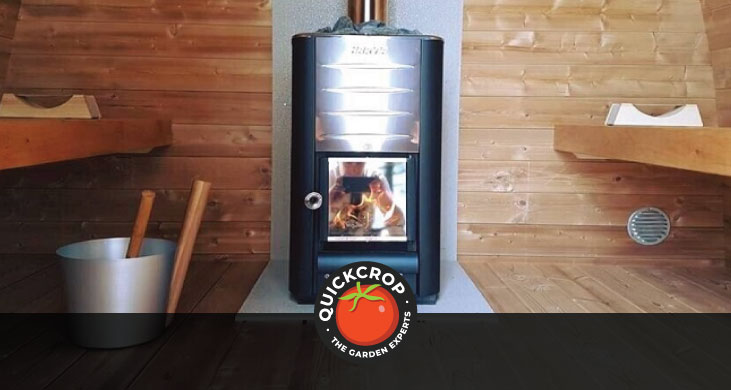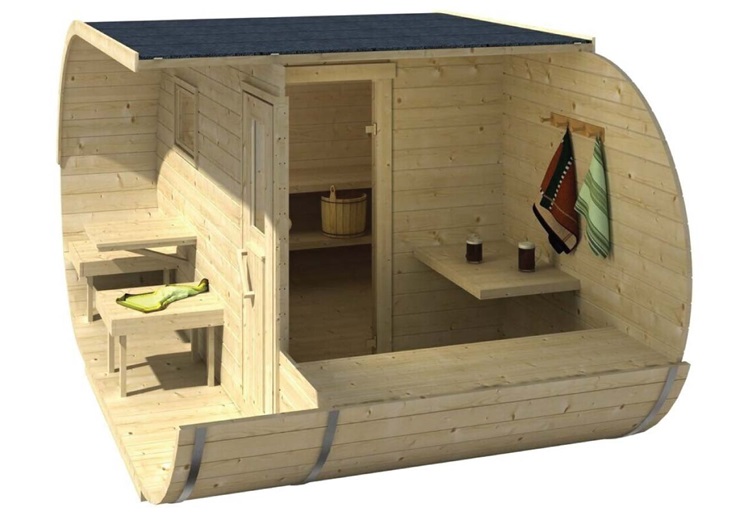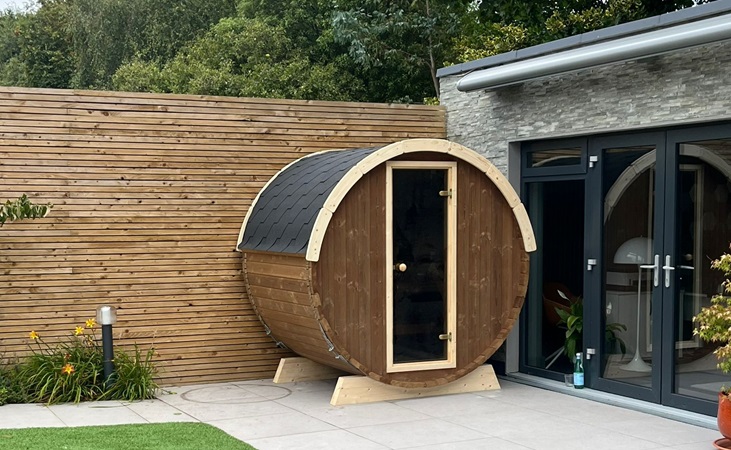Choosing the Right Home Sauna

If you’ve ever had the pleasure of using a sauna, you’ll know that it can be a serene experience. The heat relaxes your muscles and eases body tension. This can create a deep sense of well-being, while relieving troublesome aches and pains.
You might have caught yourself thinking ‘if only I could do this every day!’. Well, who’s to say you can’t. More people are taking after the Finns and opting for a home sauna that they can use at any time.

Wood Fired Oval Deluxe Sauna
View ProductIn countries like Finland or Estonia saunas have a rich cultural heritage. You will find them in hospitals, offices, and student residences, and people will even find ways to fit one into a small pokey apartment. To illustrate just how ubiquitous they are, bear in mind that there are more saunas than cars in Finland. Sauna bathing isn’t something they do as an occasional treat; it’s a way of life!
With sauna usage continuing to grow in popularity, the appeal of a home sauna is obvious. You can have a more private, solitary session or invite a small group of friends. Having one at home means that you can use it at your convenience (compared to travelling to a gym or public space). You can also choose the design and aesthetic to suit your preferences, whether you like the 'wood cabin' look or you'd prefer something more minimal.

Things to Take into Account When Choosing a Home Sauna
- How much space do you have? Saunas come in a variety of sizes.
- Your budget.
- Is it an option to install the sauna somewhere in your home? Perhaps an unused utility room, en suite or a basement.
- How many people are likely to be using the sauna? Capacity, size of benches etc.
- Ease of assembly
- Portability or permanent structure? Is it just for home use or are you looking to bring it to festivals, events, or even using it as a small business venture?
- Preferred method of heating (wood, electric, infrared)
- Aesthetics
- Dimensions: how high and long do you want your sauna to be, how much headroom etc.

An integral feature of traditional saunas is that they will have a container or compartment for stones placed upon the stove or wood burner. These stones will absorb and radiate heat, converting it to hot air (or convective heat).
Sprinkling or adding small amounts of water onto the heated rocks to create steam can briefly provide a pleasant burst of humidity. This steam creates an effect called ‘löyly’ that is a vital part of the traditional Finnish sauna experience; indeed, it’s probably something you’ve seen in any media depiction of a sauna, even if you don’t understand why exactly the person is doing it. Well now you know!

Wood Fired Barrel Sauna - 400
View ProductThe median room temperature can range between 75-105 °C. The optimal time for ‘sauna bathing’ is thought to be in or around 10-15 minutes; if you’re a beginner, it’s best to start with very short sessions until you get an idea of how comfortably you can adapt to the heat.
It’s a common tactic to combine short bursts of sauna bathing with periods of cooling down. Some will take this cooling down to the extreme by going straight for a cold shower or even plunging into some icy water.
Another common practice is ‘vihta’: this is where you use bundles of branches (traditionally. birch branches tied with twine) to gently whip your limbs or other parts of your body. It is believed to increase blood circulation and further enhance relaxation.

To enhance the vibe, you can add aromatherapy to the mix by adding essential oils: eucalyptus oil is particularly popular with sauna users, but cinnamon, birch and lavender are others you can try out. The best way to do this is by adding a few drops of oil to the water bucket before adding water to the stones.
Sauna Types: Methods of Heating
Electrically Heated Saunas
This method of heating the space may (arguably) lack the aroma and ambience of wood fired saunas, but on the other hand you will have more precise control over temperature. The convenience of an electrically heated sauna is a big factor in its appeal: it’s usually as simple as flicking a switch, and it will heat up quicker than a wood fired sauna.
With an electric stove heater it’s still common to have your stones or rocks placed atop it, and you can still partake in ‘ladling’ water onto the stones for bursts of steam.

With an electrically heated sauna you will of course need a power supply. Most freestanding saunas will require a 240V outlet source.
Gas-Fired Saunas
This type of heating is less common and tends to be used in more expensive saunas. They will require proper installation and ventilation to ensure that they are safe to use.
Wood Fired Saunas
In many ways this is regarded as the most authentic sauna type - if you’re into authenticity that is! More modern kinds have their own benefits, but nothing really beats the off-grid log cabin vibe if you ask us. Wood fired saunas will include a chimney to allow smoke to escape. The stove or heater is fueled by burning wood such as logs or timber.
Wood burning saunas produce very low humidity levels (around 5 to 15%), resulting in a dry heat experience. A wood fired sauna will commonly have a chimney, although in traditional Estonian or Finnish ‘smoke saunas’ it’s customary to let the smoke fill the space before periodically venting.

Wood Fired Barrel Sauna - 220
View ProductOne of the benefits of this type of sauna is that you won’t need to worry about having a power source for the sauna itself, making them very suitable for outdoor placement. They can be situated a fair bit away from your house (if you have the space), allowing for a more secluded experience. The natural, rustic aesthetic of these barrel saunas also makes them an ideal addition to your outdoor space. If you have a reliable supply of wood for your sauna, then all the better as you will save on running costs. In general wood is a renewable fuel source. Dry and medium-sized firewood is best.
Infrared Saunas
An infrared sauna is a different kind of sensation. Instead of the whole space heating up gradually, an infrared sauna will directly heat your body using panels that emit infrared waves. This means that they can take less time to produce the desired heat or effect.
Infrared saunas have their fans, many of whom swear by the positive health benefits. But there are also a lot of people who find it a bit of a weird and slightly uncomfortable experience in comparison to traditional wood fired or electric saunas. One user described it as ‘feeling like they’re being cooked from the inside out’. Yikes! Indeed, sauna purists question whether they can be accurately called saunas at all. But we won’t get into all that!
On the other hand, infrared saunas can be easier to install in small indoor spaces as less planning needs to be taken into account when it comes to things like ventilation, vapour barriers, and so on. They consume less energy or fuel compared to electric or wood fired saunas. And they can operate at milder temperatures, which some people prefer and can handle for longer periods of time.

Thermo Pool Sauna
View ProductSauna Types: Design
Indoor Saunas
Indoor saunas can be installed in a home in much the same manner as they are in gyms and public places. This can be an option if you have the space; they are often placed beside bathrooms or washrooms. While barrel or cabin-type saunas can be installed indoors, it’s typical to see a more minimal design that’s tailored to your indoor space.
From a quick glance many indoor saunas have the appearance of a large walk-in shower, with transparent doors and benching. There are countless possible designs, though. The important thing is to consult with professionals when it comes to installing, electricity connections etc. If you’re going with an indoor sauna, you will need an additional vapour barrier to safeguard against moisture damage to roofs and walls.
Cabin Saunas
Cabin saunas tend to have the appearance of a workshed or of course a cabin. They tend to be very well-insulated structures with a sealed construction and a gently sloped roof. It’s a simple and minimal design that nonetheless remains very popular with sauna enthusiasts.
Height restriction will be less of an issue with a cabin sauna compared to barrel saunas, where the shape will naturally cause the ceiling to be a fair bit lower in some places. The typical cabin design allows more space for two (or more) tiered seating in the sauna (on lower benches the heat will be less intense, so people with different heat tolerances can choose between the two).
On the other hand cabin saunas tend to be built as more permanent structures, and lack the portability of barrel saunas.
Pod Saunas
Pod saunas have a distinctive-looking teardrop or igloo shape. They have a very charming, almost ‘enchanted forest’ aesthetic. The tall structure allows for a nice amount of headroom.

Wood Fired Pod Sauna
View Product
Barrel Saunas
Barrel saunas are so-called because of their cylindrical shape, which really does look like you’re entering a barrel lying on its side. It’s a very charming and visually striking design, but it’s not just about looks: the design is actually intended to make heat dispersal in the sauna more even, as we’ll see below. A good-quality barrel sauna will be crafted from a durable wood type that can withstand the outside elements. The wood can be thermally treated to make it even more resistant, as well as improving its heat retention qualities. Whichever type you choose, the wood in a barrel sauna is designed to expand with heat, which will help keep heat and humidity within the structure.
With more square-shaped cabin saunas there can sometimes be an issue where the sauna is hotter higher up, with colder patches around your feet. This is because of the natural way that heat rises. Barrel-shaped saunas mitigate this effect because they cause the warmed air to circulate more evenly and efficiently. Overall there is less unused space in the structure to be warmed up (such as in the corners). This also means that the sauna can heat up faster.
Barrel saunas aren’t insulated in the way that cabin structures are, but the kind of good-quality wood used in sauna construction has a natural insulating quality; this is even more true with treated Thermowood options (see below). With an outdoor barrel sauna the wood will be designed to expand and contract smoothly with changes in temperature.
View Product: Wood Fired Barrel Sauna - 330
This natural expansion will prevent heat and moisture from escaping when the sauna is in use. The Estonian-made saunas that we supply at Quickcrop also feature a shingle roof covering that bolsters insulation and helps prevent against water leakage. The extra weather resistance will add to the wood’s lifespan.
Heat loss can occur when the door is opened, but this can be mitigated if the barrel sauna features a changing room between the sauna itself and the outdoors.
Needless to say, wood has a charming and warm aesthetic that adds to the cosy, inviting feel of an outdoor sauna. Half moon or full moon glass allows you to take in the surrounding scenery while you’re chilling (or baking to be more exact). Furthermore, they lend themselves to portability and ease of assembly more than traditional cabin designs: this can be very handy if you’d like to fit the sauna to a trailer and bring it to festivals or on camping trips.
Thermowood
For extra heat retention capabilities, it’s a good idea to pay a bit extra for Thermowood (the other option with the barrel saunas we supply is durable Spruce timber - which to be fair is no slouch itself). Thermowood is created by treating the wood with very high heat (185-205°C) in an airless environment. This process changes the molecular make-up of the material, increasing moisture resistance and making the wood less susceptible to decay or rot. Wood that has been treated this way will have superior insulating qualities, and will stand up better to changing weather conditions. The treatment will also result in a darker colour, with a finish more like cedar. No chemicals are used in the thermo treating process.
Barrel Sauna: Front and Back
When ordering the barrel saunas that we supply at Quickcrop, you have a choice of opting for a timber front with a glass door, or going all out with a full glass front complete with glass door. Allowing light in can really enhance your sauna experience, particularly if your location has some nice natural scenery to take in. Similarly, for the back end you can go with a 'half moon' design with half of the area designed to let light in.




